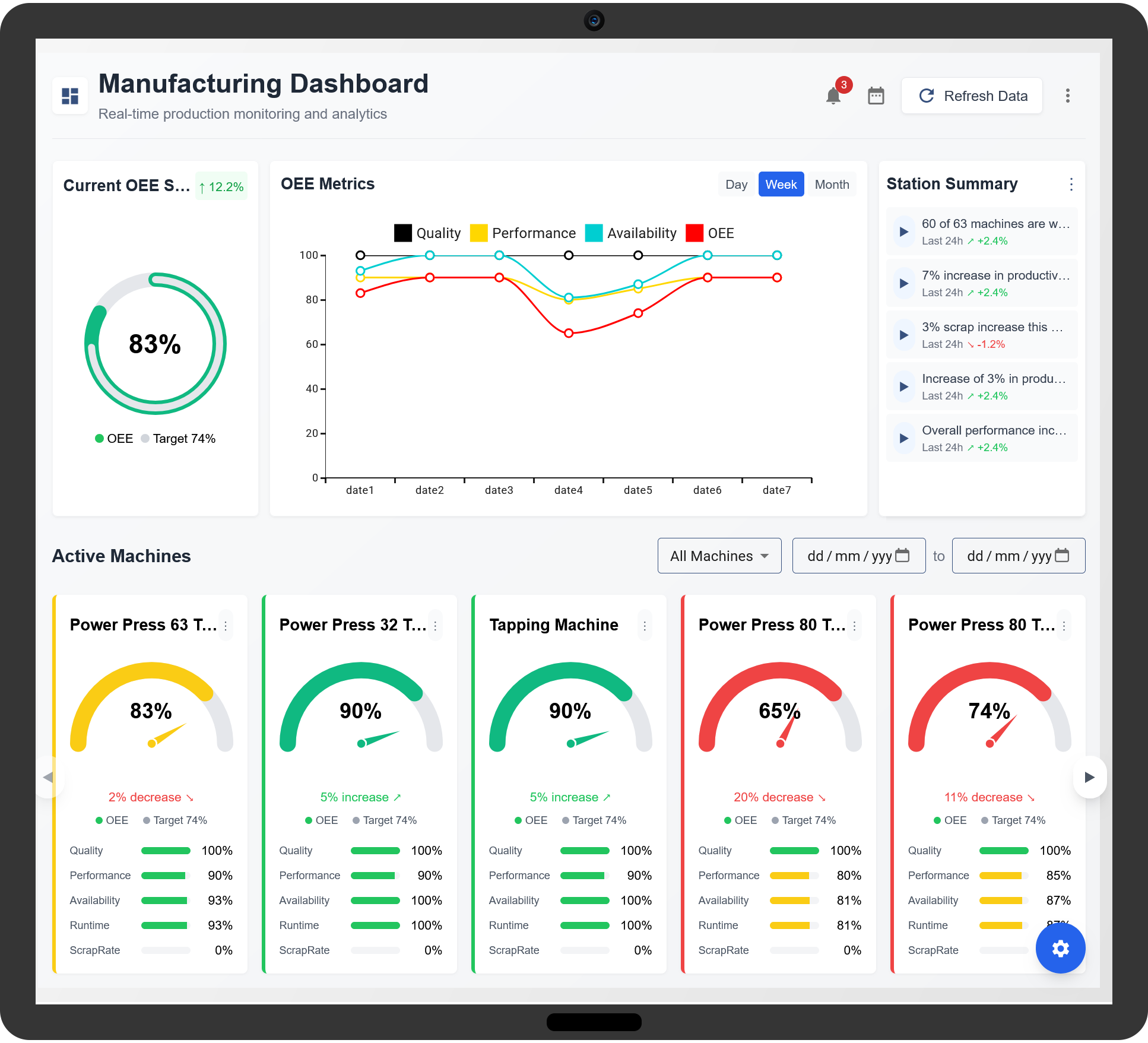In the manufacturing industry, production downtime is one of the most significant challenges that businesses face. Whether caused by machine malfunctions, slow performance, or quality issues, downtime leads to reduced efficiency, higher costs, and lost revenue. To mitigate these challenges, manufacturers are increasingly turning to tools like SAP Overall Equipment Effectiveness (OEE). SAP OEE is a comprehensive solution designed to help businesses track and optimize equipment performance, ultimately reducing downtime and improving overall production efficiency.

Understanding SAP OEE
Overall Equipment Effectiveness (OEE) is a critical metric used in manufacturing to assess how effectively equipment is being utilized. It combines three important factors: availability, performance, and quality. SAP OEE is a tool integrated into the SAP platform that helps manufacturers measure these factors and identify areas where improvements can be made. By continuously monitoring OEE, businesses can gain valuable insights into where their equipment is underperforming, enabling them to take corrective actions to reduce downtime.
The Three Pillars of SAP OEE
SAP OEE works by evaluating equipment effectiveness across three main pillars:
- Availability: Measures the percentage of scheduled production time that the equipment is available for use. This factor takes into account any downtime, such as unplanned stoppages due to machine breakdowns, maintenance, or other operational delays.
- Performance: Evaluates how fast the equipment operates compared to its optimal speed. Performance losses occur when equipment is running slower than its maximum capacity, often due to inefficient processes, mechanical issues, or operator error.
- Quality: Focuses on the number of products produced that meet quality standards. Defective products or those that require rework result in a reduction in the overall quality score, which directly impacts production efficiency.
These three factors are combined to calculate the OEE score, which helps manufacturers assess how well their equipment is performing overall. A high OEE score indicates minimal downtime, optimal performance, and high-quality output, while a low score points to areas that require improvement.

How SAP OEE Reduces Production Downtime
One of the primary ways SAP OEE helps reduce production downtime is by providing real-time visibility into equipment performance. With accurate, up-to-date data on availability, performance, and quality, manufacturers can identify the root causes of downtime and take immediate corrective actions. Below are several ways SAP OEE helps reduce downtime:
1. Real-Time Monitoring and Alerts
SAP OEE enables manufacturers to monitor their equipment in real time, tracking performance, availability, and quality as production progresses. This continuous monitoring ensures that any issues—whether they are related to downtime, performance slowdowns, or quality problems—are detected immediately. When issues are identified, the system can send automated alerts to operators, maintenance teams, and managers, prompting them to take corrective actions without delay. This proactive approach helps prevent minor issues from escalating into larger, more costly downtimes.
2. Identifying and Reducing Unplanned Downtime
Unplanned downtime is a major contributor to inefficiencies in manufacturing. SAP OEE helps identify the causes of unplanned downtime by tracking the exact reasons for machine stoppages. Whether it's mechanical failures, lack of resources, or human error, SAP OEE logs these incidents and categorizes them, allowing manufacturers to analyze patterns over time. This data provides valuable insights into which machines are prone to frequent breakdowns or delays, allowing companies to schedule preventive maintenance or invest in equipment upgrades to minimize future disruptions.
3. Performance Optimization
Performance losses are another key area where SAP OEE can reduce downtime. SAP OEE tracks the actual speed of equipment compared to its ideal performance rate, identifying any slowdowns or inefficiencies in the process. By analyzing performance data, manufacturers can pinpoint causes such as suboptimal machine settings, improper calibration, or operator inefficiencies. With this information, manufacturers can make adjustments to improve the speed and efficiency of their equipment, ensuring that production runs at its maximum potential and minimizing the need for additional production time or overtime.
4. Preventive Maintenance and Predictive Analytics
Regular maintenance is essential to keeping manufacturing equipment in optimal working condition. SAP OEE helps shift maintenance from a reactive to a proactive approach by providing insights into when machines are likely to fail. By analyzing historical data and identifying patterns of wear and tear, SAP OEE can help predict potential failures before they occur. This enables manufacturers to schedule preventive maintenance at the optimal time, reducing the likelihood of unexpected breakdowns and ensuring that equipment remains in good condition for longer periods, ultimately reducing downtime.
5. Root Cause Analysis and Continuous Improvement
When downtime occurs, it's crucial to conduct a root cause analysis to determine the underlying factors contributing to the issue. SAP OEE provides detailed data on the specific causes of downtime, whether it be equipment malfunctions, operator errors, or material shortages. By analyzing this data, manufacturers can identify recurring issues and implement corrective actions to address them. The data-driven approach fosters a culture of continuous improvement, where teams are empowered to address inefficiencies and reduce downtime over time. By constantly improving processes and addressing root causes, SAP OEE helps ensure that production downtime is kept to a minimum.
6. Streamlining Production Scheduling
Efficient production scheduling is essential for minimizing downtime. SAP OEE allows manufacturers to track real-time production data and adjust schedules based on equipment performance, availability, and quality. If equipment is running behind schedule or experiencing performance issues, the system can adjust the production plan accordingly, ensuring that resources are used efficiently. This flexibility in scheduling helps minimize downtime during changeovers, setup, or unexpected delays, allowing for smoother transitions between production runs and reducing the impact of downtime on overall production output.
Integrating SAP OEE with Other SAP Solutions
One of the key advantages of SAP OEE is its ability to integrate seamlessly with other SAP solutions, such as Enterprise Resource Planning (ERP), Manufacturing Execution Systems (MES), and Supply Chain Management (SCM). By linking OEE data with these systems, manufacturers can gain a more holistic view of their operations, allowing for better coordination and decision-making. For example, by integrating OEE data with ERP systems, manufacturers can optimize inventory management and reduce material shortages that can lead to production downtime. Similarly, linking OEE with SCM systems helps ensure that production schedules are aligned with supply chain availability, reducing delays caused by external factors.
Maximizing the Benefits of SAP OEE
To maximize the benefits of SAP OEE and minimize production downtime, manufacturers should focus on the following strategies:
- Comprehensive Training: Ensure that all operators and maintenance staff are trained in how to use SAP OEE effectively. This includes understanding how to input data, interpret reports, and take action based on the insights provided by the system.
- Continuous Monitoring: Monitor OEE metrics consistently to identify trends and areas for improvement. Regularly reviewing OEE data allows manufacturers to address emerging issues before they lead to significant downtime.
- Collaborative Efforts: Foster collaboration between production, maintenance, and management teams to ensure that OEE insights are shared and acted upon. When teams work together, downtime can be minimized more effectively.
- Data-Driven Decision Making: Use the data provided by SAP OEE to make informed decisions about equipment upgrades, maintenance schedules, and process improvements. Relying on data ensures that actions are based on real-time performance rather than assumptions.
How can SAP OEE help reduce production downtime?
How can SAP OEE help reduce production downtime?
SAP OEE helps reduce production downtime by tracking equipment performance, availability, and quality in real-time. By identifying inefficiencies and potential causes of downtime, manufacturers can take proactive actions to improve machine uptime and reduce unplanned stops.
What role does SAP OEE play in identifying downtime causes?
SAP OEE helps identify the root causes of downtime by categorizing downtime events into various types, such as breakdowns, setup changes, or maintenance. By analyzing this data, manufacturers can address specific causes and reduce downtime effectively.
How does SAP OEE track downtime events?
SAP OEE tracks downtime events by logging the time machines are unavailable for production, along with the reasons for downtime. This data is collected automatically through sensors or manually entered by operators, helping manufacturers identify trends and improve uptime.
Can SAP OEE help with preventive maintenance to reduce downtime?
Yes, SAP OEE can help with preventive maintenance by scheduling regular checks and repairs based on machine performance and condition. By analyzing OEE data, manufacturers can predict when maintenance is needed, preventing unexpected breakdowns and reducing downtime.
How does SAP OEE improve equipment availability?
SAP OEE improves equipment availability by monitoring machine performance and availability in real-time. By identifying equipment issues early, manufacturers can take corrective actions quickly, ensuring that machines remain operational and available for production.
What is the impact of SAP OEE on production speed and downtime?
SAP OEE improves production speed by highlighting performance inefficiencies that slow down operations. By optimizing machine speeds and eliminating bottlenecks, manufacturers can reduce downtime and keep production moving at a consistent pace.
How can SAP OEE help prioritize maintenance activities?
SAP OEE helps prioritize maintenance activities by analyzing data on equipment performance, identifying machines that are most prone to failure, and suggesting maintenance actions based on the severity of the issues. This ensures that critical equipment is serviced first, reducing the likelihood of unplanned downtime.
What are the benefits of using SAP OEE for downtime analysis?
Using SAP OEE for downtime analysis helps manufacturers identify and quantify downtime events, allowing them to understand their root causes. With this data, they can implement corrective actions, optimize maintenance schedules, and reduce downtime across the production line.
How does SAP OEE track the performance of different machines?
SAP OEE tracks the performance of different machines by capturing real-time data on their availability, performance, and quality. It helps manufacturers compare the effectiveness of different machines, identify underperforming assets, and take corrective actions to improve overall equipment effectiveness.
How can SAP OEE improve operator awareness of downtime issues?
SAP OEE improves operator awareness by providing real-time feedback on equipment performance. Operators can track downtime events as they occur and receive insights on performance issues, allowing them to take immediate action to reduce machine downtime.
What data does SAP OEE collect to reduce downtime?
SAP OEE collects data on equipment availability, performance, and quality. It logs downtime events, including the reasons for stoppages (e.g., breakdowns, maintenance, or setup changes), and helps manufacturers identify patterns and implement corrective actions to reduce downtime.
How does SAP OEE help reduce unplanned downtime?
SAP OEE helps reduce unplanned downtime by providing real-time performance monitoring and predictive analytics. It enables manufacturers to detect potential issues before they lead to breakdowns, allowing for proactive maintenance and minimizing unplanned downtime.
Can SAP OEE help identify patterns in downtime occurrences?
Yes, SAP OEE helps identify patterns in downtime occurrences by tracking and analyzing data over time. Manufacturers can identify recurring issues, such as frequent breakdowns or setup delays, and address them with targeted solutions to reduce future downtime.
How can SAP OEE be integrated with other systems to reduce downtime?
SAP OEE can be integrated with other systems, such as maintenance management or ERP systems, to provide a comprehensive view of equipment performance and downtime events. This integration ensures a more coordinated approach to reducing downtime through predictive maintenance, real-time monitoring, and data-driven decisions.
How does SAP OEE contribute to continuous improvement in reducing downtime?
SAP OEE contributes to continuous improvement by providing ongoing data on equipment performance and downtime causes. Manufacturers can use this data to implement improvements, monitor the effectiveness of changes, and continuously refine their processes to minimize downtime over time.